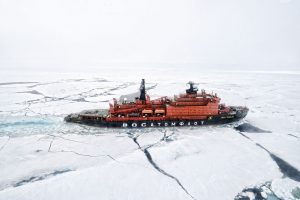The collapse of cooperation between Russia and its Arctic peers has conveniently cemented Beijing’s position as Moscow’s first partner in the region. With China-Russia relations once lionized as a “no limits” friendship by both sides, Russia in particular hopes to sell extra natural gas supplies and boost trade relations with its larger neighbor. For China, the Arctic region’s vast reserves of natural resources and the prospect of shorter shipping routes to Europe remain attractive.
Despite a prevalent narrative of strategic alignment in the region, the two countries are not as close as they might appear. The more cynical reality is that China’s Arctic engagement is primarily driven by opportunism, transactional interests, and the prospect of economic benefits.
China’s 2018 Arctic Strategy only mentioned Russia twice, as one of multiple potential partners with no explicit alignment. Since then, China’s engagement with the region has been primarily driven by expected benefits in terms of trade and resources, potentially converging with but not necessarily similar to Russia’s. The timeline of Chinese investments in the Russian Arctic, which accelerated after 2014 – the year of Russia’s annexation of Crimea – suggests that degrading relations between Moscow and the West were seen as an economic opportunity more than as a geostrategic balancing act for China.
Beijing’s opportunism in the Arctic is nothing new. China’s investments in the Arctic used to be directed at Western countries such as the United States, Canada, and Greenland through Denmark. These investments slowed down in the 2010s as China gradually lost credibility with a series of incidents, such as when a Chinese zinc mine in the Yukon went bankrupt and became an environmental disaster. Other projects, such as the $230 million gold mining project in Nunavut or the purchase of a disused naval base in Greenland, were blocked as China began to be perceived as a security threat.
China was thus forced to turn its attention to Russia, which welcomed Chinese investment as Western sanctions started mounting after 2014.
Sino-Russian cooperation in the Arctic has largely expanded over the past 10 years. It now encompasses joint ventures in infrastructure, energy security, military exercises, and diplomatic coordination within the Arctic Council.
Large-scale Chinese investment in the Russian Arctic started in 2013 when the state-owned China National Petroleum Corporation bought 20 percent of the Russian Yamal LNG natural gas processing project. In 2017, Russia and China agreed to develop the Polar Silk Road along the Northern Sea Route as part of the Belt and Road Initiative. Two years later, Chinese companies bought 20 percent of LNG-2, a natural gas processing project. In 2020, Russia designated the Arctic region as a Special Economic Zone, significantly easing Chinese investments with substantial tax incentives.
After Russia’s full-scale invasion of Ukraine in 2022, Western investment in the Russian Arctic stopped altogether. Funds for Russia to develop the Arctic as a strategic resource base, a goal stated in its Arctic strategy, dried up.
Chinese investment then doubled down. In 2023, China invested in titanium mining in the Komi Republic, showing interest in critical minerals. Other infrastructure projects such as the Moscow-Kazan high-speed railroad aimed to enhance connectivity and boost collaboration in trade, investment, energy, and manufacturing.
That year also saw increased security and military cooperation. In April 2023, China and Russia signed a memorandum of understanding to enhance maritime law enforcement cooperation, focusing on terrorism, smuggling, illegal migration, and marine resource protection.
During Russia’s chairmanship of the Arctic Coast Guard Forum, the Arctic Patrol 2023 exercises were held, with China Coast Guard representatives observing. However, it is essential to note that joint China-Russia exercises have, to date, primarily been set-piece and performative. These activities serve more as signaling efforts than a sustained attempt to develop practical interoperability, reflecting a lack of trust between the two nations. If these exercises evolve into operations that build operational performance and cooperation, it will mark a significant and notable shift in their military relationship.
Furthermore, Chinese investment has not resolved the severe infrastructure deficiencies plaguing the Russian Arctic. Currently, China and Russia still nominally focus on expanding Arctic container shipping links, exemplified by the launch of the Arctic Express No. 1, a sea-rail service from Moscow to China via Archangel and the Arctic Ocean that reduced transport time by a week. But the Polar Silk Road project was hampered by Russia’s invasion of Ukraine and the resulting antagonism from Europe, making the development of trade routes through Russian territories less appealing for China.
Although COSCO documented record voyages in 2021, no Chinese ships used the route in 2022 due to sanctions and high costs. As a result, and despite continuing Chinese rhetorical support to Russia, the Polar Silk Road has progressively faded away from official discourse.
Disagreements are also emerging on the energy front. For years, Russian President Vladimir Putin has dreamed of linking the Yamal Peninsula’s natural gas resources to China through the Power of Siberia 2 pipeline. Currently, Yamal must ship liquefied gas to China. The pipeline would provide Russia with a much-needed steady stream of funding for the government after losing most access to European gas markets. But the joint project is currently stalled on disagreements over the selling price and volume of gas as well as preferential cooperation with Chinese banks demanded by Russia.
Considering China’s economic leverage over Russia, dramatically accentuated by Russia’s war with Ukraine, expect to see more disagreements and potentially Chinese strong-arming in future negotiations between the two countries.
Beijing’s ambitions in the Arctic seem more nuanced than the Russia alignment narrative. Its economic and trade relations with other Arctic countries such as Canada and Norway have continued, despite greater scrutiny.
Although China will continue to be a partner with Russia, and driving a wedge between the two countries remains a distant prospect for the United States and its allies, it is increasingly obvious that China wants to keep its options open in the Arctic region.

































